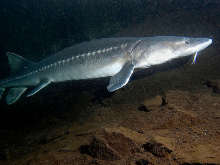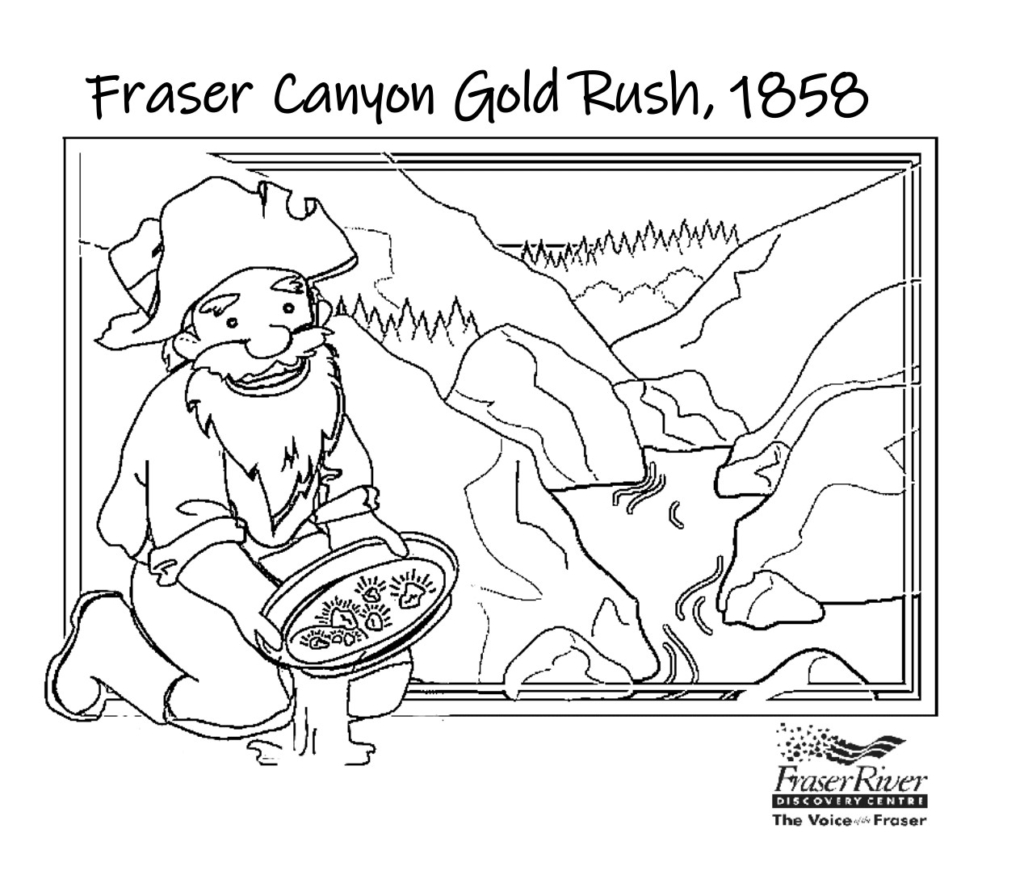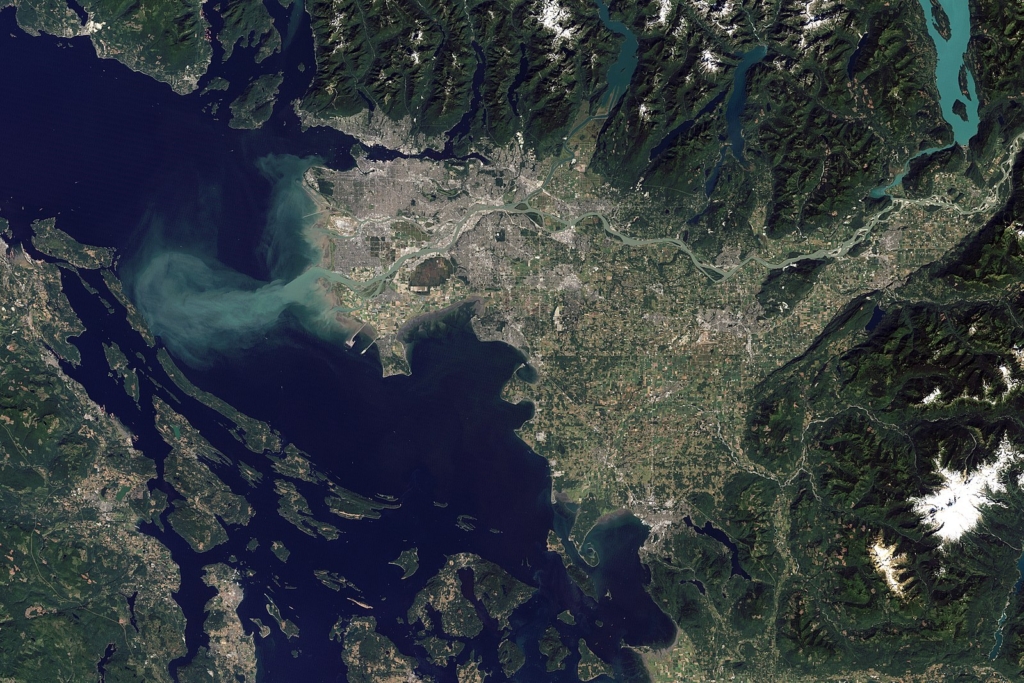WELCOME TO FRDC@HOME!
FRDC@HOME is a way to explore the Fraser River from the comfort of your own home! Scroll down to view our latest post or click on the tabs below to explore our previous posts.
Sign up for our newsletter for the latest updates. Help us fund programs for learners of all ages by making a donation.
The latest on FRDC@HOME:
Geology Rocks Part 3: Teeny Pebble Sing-A-Long!
In our last video we examined the rock cycle, and some of the different types of rocks that are made and changed with the addition of heat, pressure, and time. Today we’re finishing up our geology series with something more fun! Join us as we perform “Teeny Pebble”, a song about one pebble’s journey down the Fraser River sun in the style of Baby Beluga by Raffi!
View the lyrics sheet here: https://fraserriverdiscovery.org/wp-content/uploads/2022/04/Teeny-Pebble-Lyrics-Sheet.pdf
Explore FRDC@HOME
OSCAR Trailers
River Spills and Emergency Response!
Working on the Fraser River comes with risk, and despite efforts by companies to minimize their environmental impact while working on the river, accidents like oil spills and material deposits can happen from time to time.
Oil spills are a big problem for everyone! They can cause a lot of harm to the delicate ecosystems of the Fraser River, poisoning fish and clogging up the feathers of shorebirds so they can’t fly or stay dry. For companies, spills mean a loss of time and money as they work to clean up, while their reputation takes a hit from the wider public.
When oil spills happen, emergency response teams need to be ready to deploy immediately, and that’s where the Western Canada Marine Response Corporation comes in! In the event of a marine spill, their vessels will be on-site to manage the recovery as quickly as they can. Learn more about the WCMRC and the work they do here: http://wcmrc.com/about/our-story/
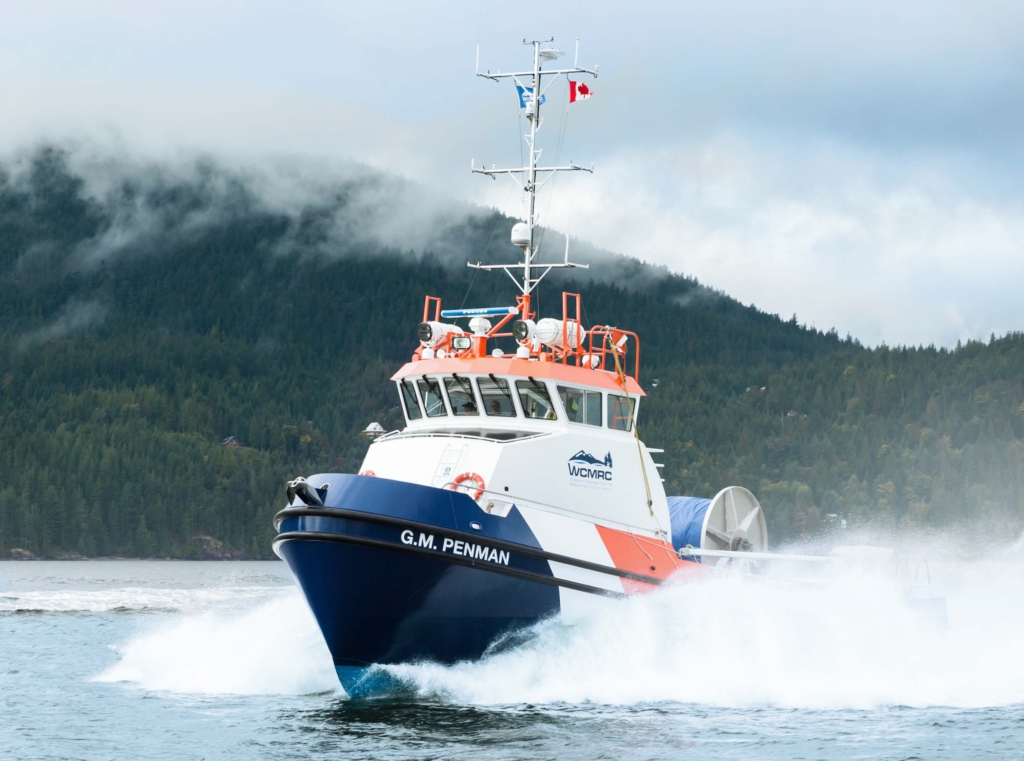
OSCAR Trailers!
What is an OSCAR Trailer? How do they help companies on the Fraser River respond to oil spills quickly and efficiently?
Find out in our OSCAR Trailer Illustrated Graphic!

Oil Spills and OSCAR Trailers
What happens when an oil spill occurs on the Fraser? Let’s find out!

How does the WCMRC Respond to Oil Spills?
When an oil spill occurs, detailed containment and recovery plans need to be put in place as soon as possible, to minimize the ecological and financial trouble that comes from these accidents. But how does the WCMRC get this work done?

How do Oscar Trailers Help?
What sort of tools and supplies are in OSCAR Trailers? How do they help emergency response teams clean up oil spills?

Dredging
Dredging the Fraser River!
As the Fraser flows across the BC landscape, it picks up a mixture of silt, clay, and sand, called sediment. This collected material, which can become highly concentrated in the river in late spring and early summer, builds up in the Lower Fraser as it is carried out to sea, and often needs to be removed so that the trade and transport vessels in the river can operate safely.
This process, known as dredging, is an important and necessary job carried out by Fraser River Pile and Dredge. Learn about the process of dredging, why its important for the economic health of the Fraser, and how we can carry it out safely.
Dredging the Fraser Illustrated Graphic
Why does the Fraser pick up so much sediment? What happens when too much of it is deposited along the river? How can we ensure it is removed safely without harming the environment?
Check out our our Dredging the Fraser Illustrated Graphic to learn more!
The Fraser River & Sediment
How much sediment is carried downriver every year? Are there times when the amount of sediment in the river increases?

Dredging the Fraser River
When the amount of sediment in the Lower Fraser becomes too high, who is responsible for clearing it?

Responsible Dredging Practices
Dredging the river is a big job and can have unintended negative side effects for the river and its inhabitants. What can be done to minimize the environmental impact of dredging?

Trade
Panning for Gold!

FRDC@HOME is digging up the past on the Fraser Canyon Gold Rush! After gold was discovered in the Fraser River in 1858, over 30,000 gold seekers from all over the world flooded the area to seek their fortune!
Bring this event today with your very own Fraser Gold Rush colouring sheet!
Tools of the Trade!
Gold prospectors in the Fraser Canyon faced many challenges seeking their fortune! They had to compete with each other to find the best spots to look for gold, had to work outside in all conditions, and had to carry all their belongings with them!
Some of these items included the tools that gold seekers used to search for gold. We’ve listed a few of them here.
Miner’s Pick

A well-looked-after pick was essential for any miner! The pick was swung into the ground to break open the earth and hopefully reveal gold. the tip was usually kept sharp and could last for years with proper care.
Oil Lamp

Miners and prospectors had to work in all conditions, rain or shine, day and night. Through it all, a reliable source of light was extremely useful to help them spot the glint of gold! With oil as fuel and a bit of string wick, these lamps would last much longer than a candle.
Gold Pan

Useful for river prospecting, the pan was used to scoop up sections of the riverbed. Swirling the water and dirt in the pan, miners could then search through the pan with their fingers, removing unwanted dirt and hopefully leaving gold behind!
Gold Ingot

Lovely, shiny gold! This is a real gold ingot from the Royal Canadian Mint. At around 30cm long and weighing 20 kilograms, in 1858 this would have been worth about $47,000. In today’s money, it’s worth an impressive $1.5 million!
Transportation
Carrying the Cargo!
Boats play a huge role in facilitating trade along the Fraser River, and cargo & container ships are especially easy to spot as they carry all sorts of goods upriver.
Bring these mighty vessels to life today and design your very own boat with our Cargo Ship Colouring Sheet! Right click the colouring sheet and select “open in new window” to get your own copy for printing.


Terrific Tugboats!
Explore the Fraser’s Tugboats for yourself with our Tugboat Fact File and Colouring Sheet!

Tugboat Anatomy Fact File
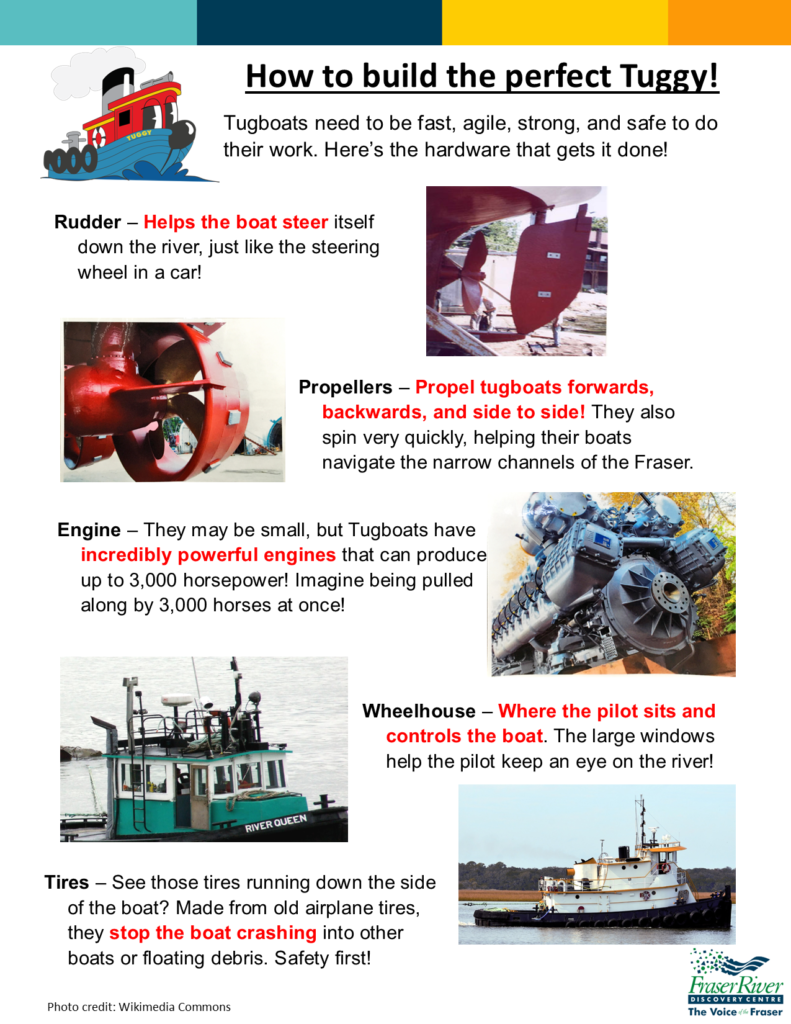
Tugboat Colouring Sheet

World Fisheries Day!
World Fisheries Day!
Held every year on November 21st, World Fisheries Day is an opportunity for all of us to consider how much our communities rely on our oceans and waterways, the aquatic life that call them home, and the work of fishing communities to provide food and job security to millions of people.
Our lives in the Lower Mainland have been shaped by our proximity to the Fraser River, which is home to one of the most productive salmon fisheries in North America! Learn more about World Fisheries Day in our illustrated graphic below!
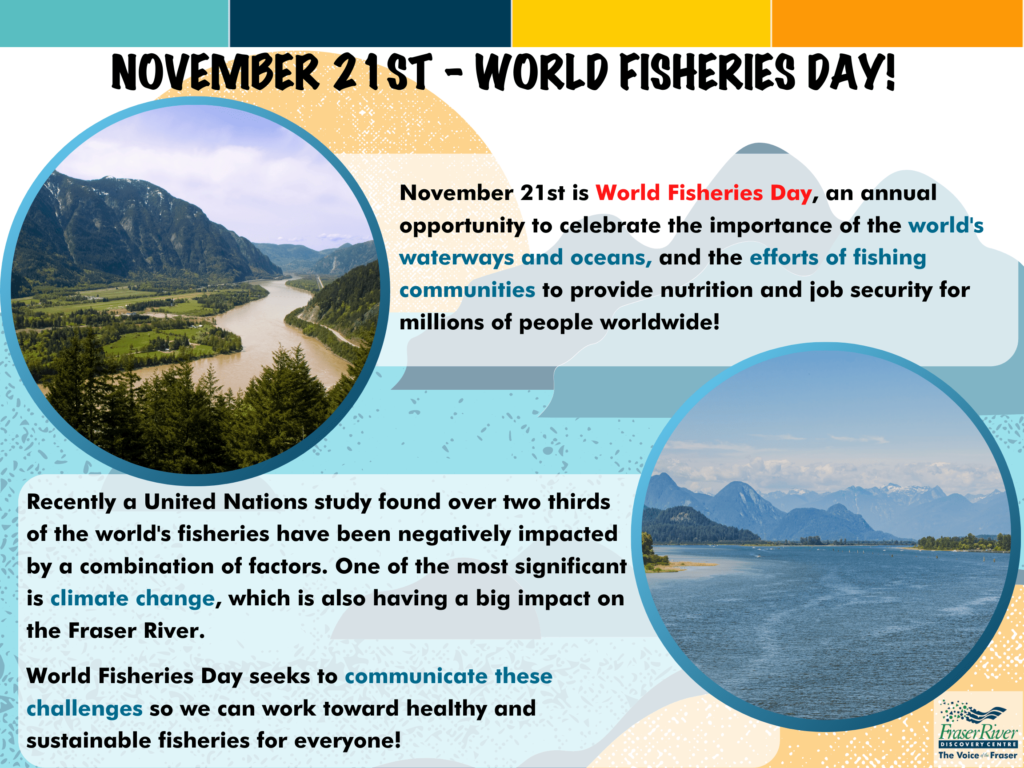
The Fraser River Fisheries
Learn more about the Fraser River’s fisheries, and why they are important to the long-term health of the river and the people that live in the Fraser Watershed!

Challenges Facing Fisheries
What sort of challenges are impacting fisheries as governments try to create a more sustainable future for this industry?

How Can We Help?
The challenges facing the world’s fisheries are serious, but that doesn’t mean we can’t help face them!

Invasive Species
Invasive Species Fact File!
Let’s say you own a pet goldfish. You love your goldfish, and one day you decide to set it free in your local pond. The following year, you pass by the pond and see goldfish everywhere! How did this happen?
Unfortunately, your goldfish has become an invasive species – a living thing introduced to a place it does not normally belong!
Let’s check out some of these invasive species that threaten the biodiversity of the Fraser Watershed!
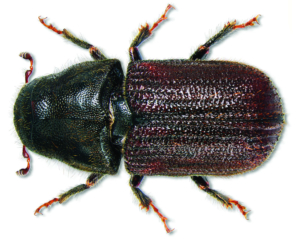
Mountain Pine Beetle
Native to the Rocky Mountains. Their larvae eat the wood of pine trees. In the 1990s & early 2000s, their population exploded due to warm winters and long summers. Over 18 million hectares (over 33 million football fields!) of forest was impacted.
Learn more about this species HERE
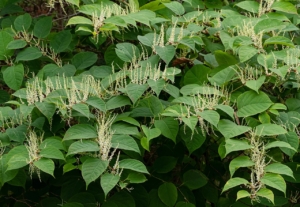
Japanese Knotweed
This plant is native to Japan and was introduced to BC as a houseplant. Now, they are considered as one of the worst invasive species in the world by the International Union for Conservation of Nature (IUCN). They can grow in all kinds of soil and spread quickly, taking up space and blocking sunlight for other plants.
Learn more about this species HERE
North American Bullfrog

Introduced to BC in the early 20th Century by frog farmers. A few escaped into the Fraser Wetlands, and threaten biodiversity there. Bullfrogs are larger than native Red-legged and Pacific Chorus frogs, and they will eat anything they can fit in their mouths including insects, other frogs, and even birds!
Learn more about this species HERE
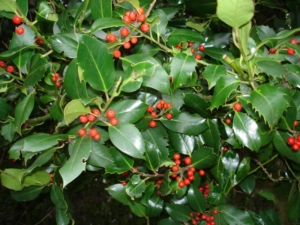
English Holly
Easy to spot from its bright red berries and spiky, glossy leaves, English holly has become a serious invasive species because of its ability to quickly grow even in low sunlight. Its berries are an irresistible treat for birds, who spread its seeds far and wide!
Learn more about this species HERE
Northern Pike

Although native to BC, Northern pike are considered an invasive species to the Fraser Watershed, as they were introduced here as a commercial and sports fish. They are extremely aggressive and will eat anything they can catch, including fish, rodents, and waterfowl.
Learn more about this species HERE
Fraser River Wetlands
Fraser Wetlands Illustrated Graphic!
What exactly is a Wetland? How do they help the wildlife of the Fraser River? Why is it so important that we help protect and preserve these delicate habitats?
Find out today in our Fraser Wetlands Illustrated Graphic!
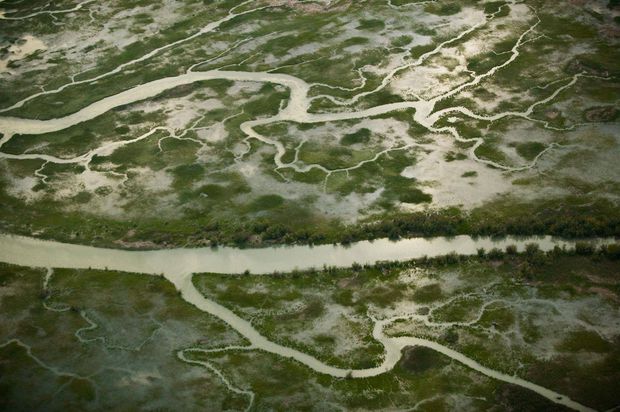
What are Wetlands?
How do we define Wetlands? What sort of habitats could we expect to discover while exploring them? Let’s find out!

Why are the Wetlands Important?
Discover why these regions are so important to the long-term health of the Fraser River and the wildlife that calls it home.

What Challenges do these Habitats Face?
Balancing the economic and environmental needs of the Fraser River is complicated, and these fragile habitats need to be protected!

Western Hemlock Looper Invasions
Invasion of the Western Hemlock Looper Moths!
In the fall, the Lower Mainland often sees huge infestations of Western Hemlock Loopers, a species of moth native to interior and coastal BC. These moths gather in large numbers in late summer and early fall, as adults come together to mate and lay their eggs before dying. Their population can grow significantly due to mild winters and long, warm summers, and this could pose a big problem for the trees of the Fraser Basin!
Why are there so many Western Hemlock Looper moths in the Lower Mainland in the fall? Where do they come from? Why could they pose a serious risk to the long-term health of the Fraser Basin? Find out today in our fact file!

Sturgeon
Ghostly Sturgeon!
We’re featuring one of the Fraser’s most famous – and elusive – residents, the White Sturgeon! Having remained largely unchanged since the time of the dinosaurs, these ‘Ghosts of the Fraser’ spend most of their days on the riverbed hidden from sight, which is impressive considering they can grow up to six metres long!
Bring these shy giants home with you today with our Sturgeon Colouring Sheets!

Sturgeon Anatomy
White sturgeon are among the oldest species of freshwater fish in North America, dating back an incredible 200 million years! Over time they have developed a number of adaptations to help them thrive in the turbid waters of the Fraser River. Discover some of these adaptations today with a closer look at white sturgeon anatomy!

Living Dinosaurs Word Search!
Let’s continue our exploration of the elusive White sturgeon in our Living Dinosaurs word search! Test your skills and see how many words you can spot!
After you’ve found some, why not do a little research to learn more about these remarkable fish? Who knows what you could learn!
To download the word search, click on it and a larger printable version will open for you.

Pollution to Solution
From Pollution to Solution!
The Fraser River basin is home to over 60% of the population of BC and is the most economically active region in the province!
In order to maintain its importance, the river must be protected! Let’s find out some of the issues affecting the health of the river, and the action we can take to ensure it stays healthy, productive, and sustainable!
A River Worth Protecting
The river is an important habitat for plants and animals in the Fraser Basin, as well as an integral part of BC’s economy!

Erosion
What do you think will happen when plant life is removed from the riverbank to make room for construction projects?

Water Pollution
How does water pollution impact the Fraser? What different types of pollution are there? Let’s find out!

What Can We Do To Help?
Protecting the Fraser River is a big challenge, but possible if we all work together! Find out some of the ways we can be great stewards of the river.
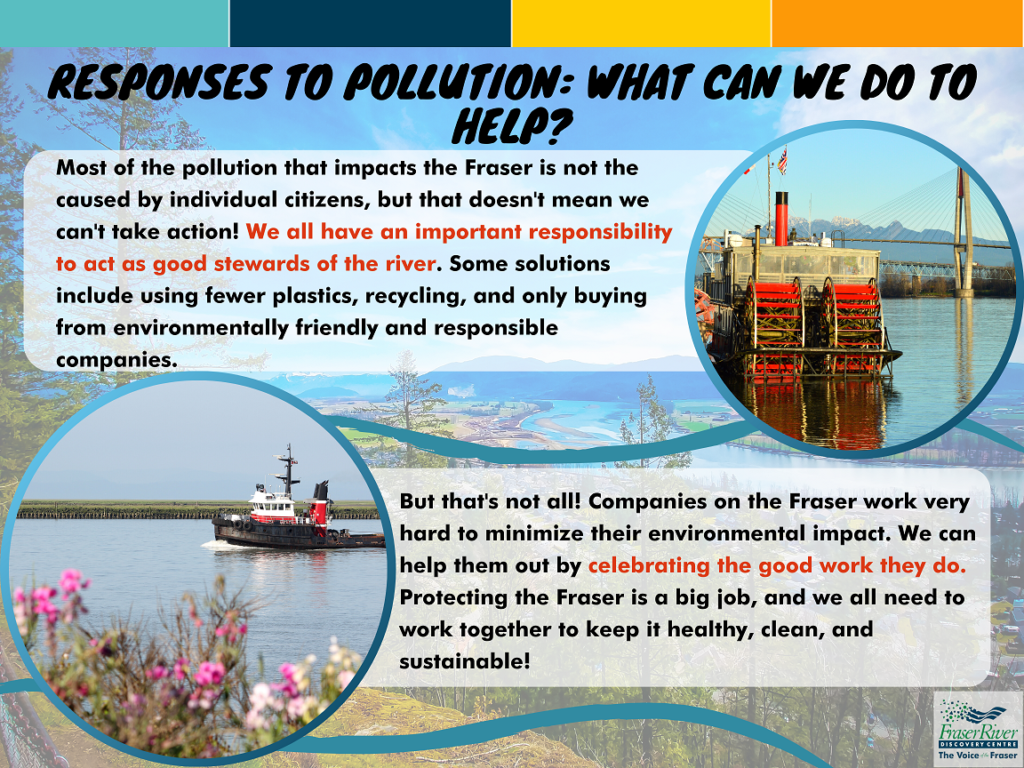
The Mighty Fraser
The Mighty Fraser!
A trickle of snow-melt in the Rockies. A torrent surging through Hell’s Gate. A majestic waterway in the Lower Mainland. The Fraser River is all of these and more!
Discover the Fraser today in our River Basin Graphic.

The Fraser’s Beginning
The Fraser River begins its journey as a small trickle of meltwater near Fraser Pass, in the Rocky Mountains. Take a look and learn more about the river’s source!

The Fraser Canyon
As the river travels through BC, it cuts a deep gorge through the landscape called the Fraser Canyon, and flows faster as it grows larger!

The Estuary
As the river enters the Fraser Valley, it slows down and grows wider, creating a large estuary that flows majestically into the Salish Sea.

The Many Uses of the Fraser!
We rely on the Fraser River in so many ways. Its waters provide us with food and fun from fishing, an ideal trade route for goods and services to and from the coast, and picturesque landscapes! Discover some of the ways we rely on the Fraser today in our River Use Word Search! There’s some tricky words to find here, so be sure to look up, down, and side to side. Good luck!

Salmon
Scintillating Pacific Salmon!
Few inhabitants of the Fraser are as important as the world-famous Pacific Salmon!
Learn more about these fish today with our Salmon Graphic!

Spot the Differences
There are five different species of Pacific Salmon (and two others in the Salmonid family) that migrate up the Fraser River every year, and all have a very unique appearance!
Take a look and see how many differences you can spot!

Salmon Life-cycle
Pacific Salmon go through a lot of change form egg to adult, and each stage gives them a unique appearance, size, and challenges!
Check out the life-stages of salmon here.

Keystone Species
Ever heard of the term ‘Keystone Species’ before? They’re a type of animal or plant that is extremely important for the health and stability of their ecosystems.
Without them, the whole system would be in very big trouble, and may even collapse!

Become a Wildlife Detective!
Become a Wildlife Detective!
Most animals in the Fraser Basin are shy and secretive – for many, their survival depends on not being seen! However, with a little training we can spot clues they leave behind, and figure out which animals might have made them. Check out some techniques here!
Wild Food Leftovers
Keep an eye out for nibbled nuts, fruits, and seeds, chewed leaves, broken snail shells, or stripped pinecones. Where were these leftovers found? Are there possible shelters or hiding places nearby? What can we learn about an unknown animal based on the food it likes to eat?
Calls of the Wild
Stay up after dark and listen for distant owl calls. Owls make all kinds of noises, from hooting to soft cooing, and even screeching! What other animals calls can you hear? How large or small do you think they might be, based on the pitch or volume of the call? Are they nearby or far away?
Animal Trails
Many animals use regular pathways to travel between shelters and feeding spots, even in built-up neighborhoods near the river. Look for gaps in fences, flattened grass, or wooded areas where branches may have been snapped or rough trenches carved through the undergrowth.
Animal Homes
Home sweet home! All animals need shelter, but they can sometimes be hard to spot. Look for holes in tree trunks, spaces between buildings and in the undergrowth. Think about how the size, shape, and species of an animal might affect where it looks for shelter.
Animal Droppings
That’s right, poop! Or to use the more technical term, animal droppings. Different kinds of animals produce all sorts of droppings – can you determine which animals produced which? Think about where you find the droppings or how big/small they are.
Plants of the Fraser River
Plant-life in the Fraser Basin!
The Fraser River basin is home to an incredible variety of plant and animal life that continues to draw in naturalists, conservationists, and nature lovers from across Canada and beyond! Let’s check out some of the plant life that thrives alongside the river.
Lodgepole pine
One of the most commonly found trees in BC, lodgepole pines can grow up to 30 metres tall and have thin, spreading branches. They are an important source of wood pulp and lumber for construction and furniture!
Learn more about this species HERE
White spruce
Also known as Canadian spruce, this is a large evergreen tree well-suited for survival in the Canadian landscape. It can grow up to 40 metres tall and 1 metre thick, and can survive temperatures as low as −56.5 °C! Brr!
Learn more about this species HERE
Quaking aspen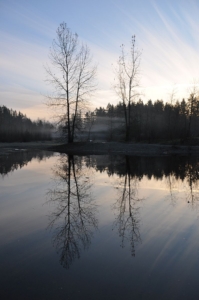
These trees get their name from the way their leaves seem to shake and shudder in the air, which is caused by the thin and flexible stalks their leaves are attached to!
Learn more about this species HERE
Saskatoon berry
Saskatoon berries look a lot like blueberries, though they’re more closely related to apples! Berry bushes grow across the Fraser basin from sea level to mountain peaks, and bloom with white flowers every spring.
Learn more about this species HERE
Sword fern
Sword fern is a large evergreen fern commonly found in coastal BC. it can grow up to 1.5 metres tall and has long, blade-like branches that grow out of a central point. This is where the plant gets its name. Next time you’re out walking, see if you can spot one!
Learn more about this species HERE
Plant Life Word-Search!
Cedars, salmonberries, dogwoods, oh my! The Fraser Basin is home to a huge variety of trees, ferns, and flowers, and all have uniquely descriptive names! See if you can spot some of them in our BC Plant Life word-search!
After you’ve found some, why not do a little research to learn more about them? Who knows what you could learn!
Simply click on the word search and a copy will open in a new window for you.
Migratory Birds and the Fraser Estuary
Migratory Birds and the Fraser Estuary
Both Spring and Fall are very important seasons for the birds of the Fraser River Basin. the river’s estuary becomes a temporary home to thousands of migratory birds travelling along the Pacific Flyway to seasonal nesting sites!
Start the week with a warm welcome for our feathered friends with our estuary colouring sheet!

Fraser River Estuary Colouring Sheet
Carbon Dioxide Balloon Experiment!
Carbon Dioxide Balloon Experiment!
The vibrant and thriving ecosystems of the Fraser River Basin would be unable to survive if not for an important, invisible gas: carbon dioxide! This gas is in the air we exhale and plants need it for photosynthesis – transforming sunlight into the energy they need to stay healthy.
But how can we showcase something we can’t even see? By creating some, of course! Try out this fun take-home experiment and learn how to create carbon dioxide fore yourself!
Find the instructions here!

Canadian Heritage Rivers
Canadian Heritage Rivers Coloring Sheet!
From coast to coast to coast, the Canadian Heritage Rivers system offers Canadians the opportunity to experience these breathtaking waterscapes, learn about their rich history, and act as effective stewards of the river. Healthy river systems benefit us all, and we have a responsibility to protect, preserve, and celebrate our wonderful rivers!
Celebrate our river systems today with our Canadian Heritage Rivers Colouring Sheet! Simply click on the sheet and a printable version will open for you.
The Fraser Valley Flood
Flooding on the Fraser!
Let’s dip into a natural phenomenon that can pose a challenge to communities living by the Fraser: flooding. The Fraser River Basin covers a huge chunk of BC – 25% of it, in fact! Every spring, snow-melt and rainfall causes the river to swell, and sometimes this can cause flooding throughout the Basin.
Join us this week as we examine how the historic 1948 Fraser Valley Flood impacted communities of the Lower Fraser, and continues to shape our relationship with the river today!

The Fraser Watershed & Flooding
How does snow-melt and seasonal rains impact the river’s water levels?
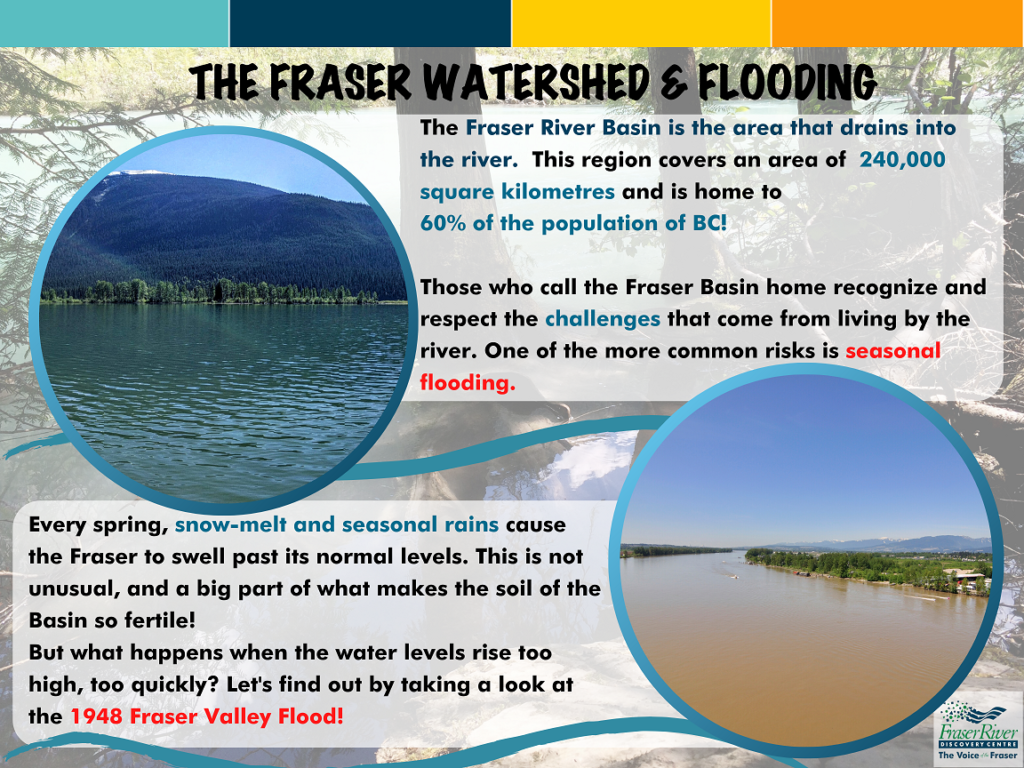
The 1948 Fraser Valley Flood
Find out what happened in 1948 when the river burst its banks and flooded the Fraser Valley!

Impacting Communities
How does flooding impact affected communities? How long do you think it takes to recover? Let’s find out!

Recovery and Mitigation
How have events like the 1948 flood changed how our communities grow alongside the Fraser today?

The Cow Story
Fraser River Cow Story!
The Mighty Fraser has many interesting and engaging stories to tell, and one we’d like to share today involves an unlikely hero: a cow! In 1996 a cow from Rosebank Ranch, located between Lillooet and Lytton, was chased into the river by dogs and was caught in the strong currents!
Unable to get out, she floated 100km downriver over the course of a week, including going through Hell’s Gate! Named by Simon Fraser himself, Hell’s Gate is where the Fraser Canyon ends, and the Lower Fraser begins. This spot is only 35 metres wide, and the water can be 150 metres deep as it thunders through at 15 million litres per second! Incredibly, our cow not only survived, but made it out without a scratch!
The cow was eventually found near the Alexandra Bridge after multiple rescue attempts, and returned to the Rose Bank Ranch!

FRDC@HOME Sit Spots
Welcome to the Fraser River Discovery Centre’s online nature activities: Sit Spots!
In our busy lives, it’s easy to take for granted the beautiful and vibrant natural world that surrounds us. If you pause and take a look around, you might be surprised by what you might notice!
This is where the Sit Spot comes in. A Sit Spot is a spot where you sit and make observations about the natural world. You return to your Sit Spot often, to learn more about this spot over time.
Check out our introductory video below, and be sure to check out the full playlist on our YouTube Channel!
View the video summary here: https://bit.ly/3afncFS
View the video transcript here: https://bit.ly/3ag1hOL
Crafts@Home with the Fraser River Discovery Centre!
Welcome to our Crafts@Home page! Here, we will be sharing craft activities and tutorials that you can try out from home, complete with examples and instructions!
To get started, you can see our most recent craft below, or check out the full playlist on our YouTube channel!
Geology Rocks Part 2: Rock Weathering Experiment
In our last video we explored the many layers that make up planet Earth. Today we’re going to take a closer look at the types of rocks that we can find in our natural surroundings, how they form, and how physical and chemical processes can weather them over time!
As part of it, we’re doing a science experiment exploring some of these weathering processes!
Find the material list here: bit.ly/3IQWxNw
Seasonal Activities!
Throughout the year, the Fraser Watershed continuously changes shape, swelling with snowmelt in the Spring, becoming a temporary home to thousands of migratory and resident birds, and changing into a wintery wonderland in the colder months. To celebrate the changing face of the Fraser, we’r ehappy to share seasonal activities you can watch, play, and try out at home!
Wild Crown Craft
Wild Crown Craft – Show off your style with these regal seasonal accessories!
Fall in the Fraser Watershed is one of the most busiest and most beautiful times of year in British Columbia! Everywhere you go the leaves are changing colour, the days are getting shorter, and the chill in the air promises winter. A season as beautiful as fall needs an appropriately pretty craft to go along with it, and what could be better than crafting regal crowns using only fallen leaves? That’s right, this craft only needs leaves, meaning zero waste! The only limit to your crown is your imagination! Let it soar and create something breathtaking!
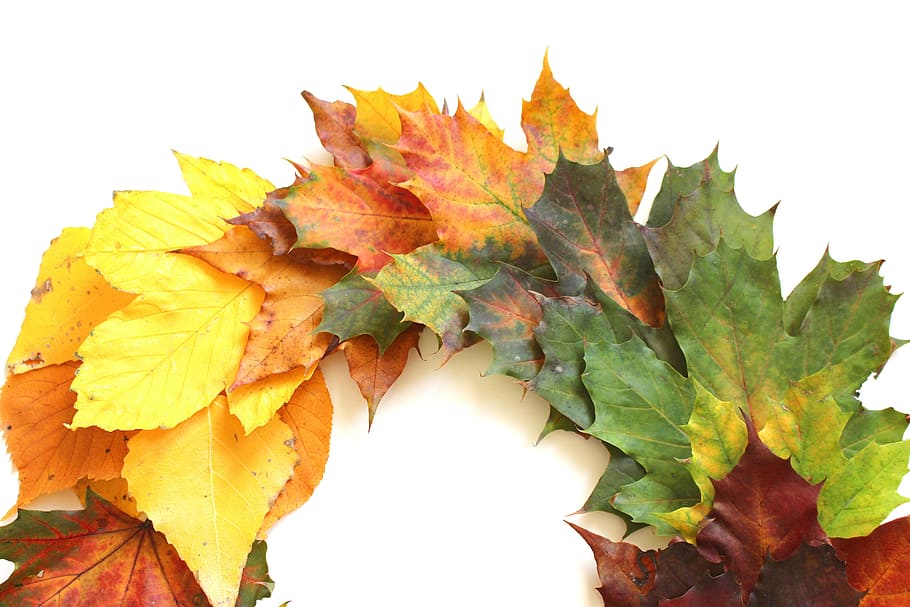
Leaf Mobiles
Leaf Mobiles – Catch the Colours of Fall with these Beautiful Hanging Ornaments!
Fall is in full swing, and across the Fraser Basin deciduous trees are beginning to lose their leaves. Let’s celebrate this change with some DIT hanging mobiles using fallen leaves! A simple and straight-forward craft fun for the whole family!

Festive Winter Activities
Festive Crafts and Activities!
Despite the cold and shorter days in the wintertime, the Watershed is buzzing with wildlife, some right under our noses! Rodents and small mammals scurry through the undergrowth looking for food and warmth. Birds flit from tree to tree, while in the Fraser River fish go about their days as usual!
In this seasonal FRDC@HOME, we invite you to celebrate the season with festive activities that all take a closer look at the wintertime activities that happen along the Fraser riverbank!
Check out the video here: https://www.youtube.com/watch?v=bHc_Qd3XVHE
Craft Instructions: https://bit.ly/3gIgUjv
Craft Printout: https://bit.ly/3abiVUt

